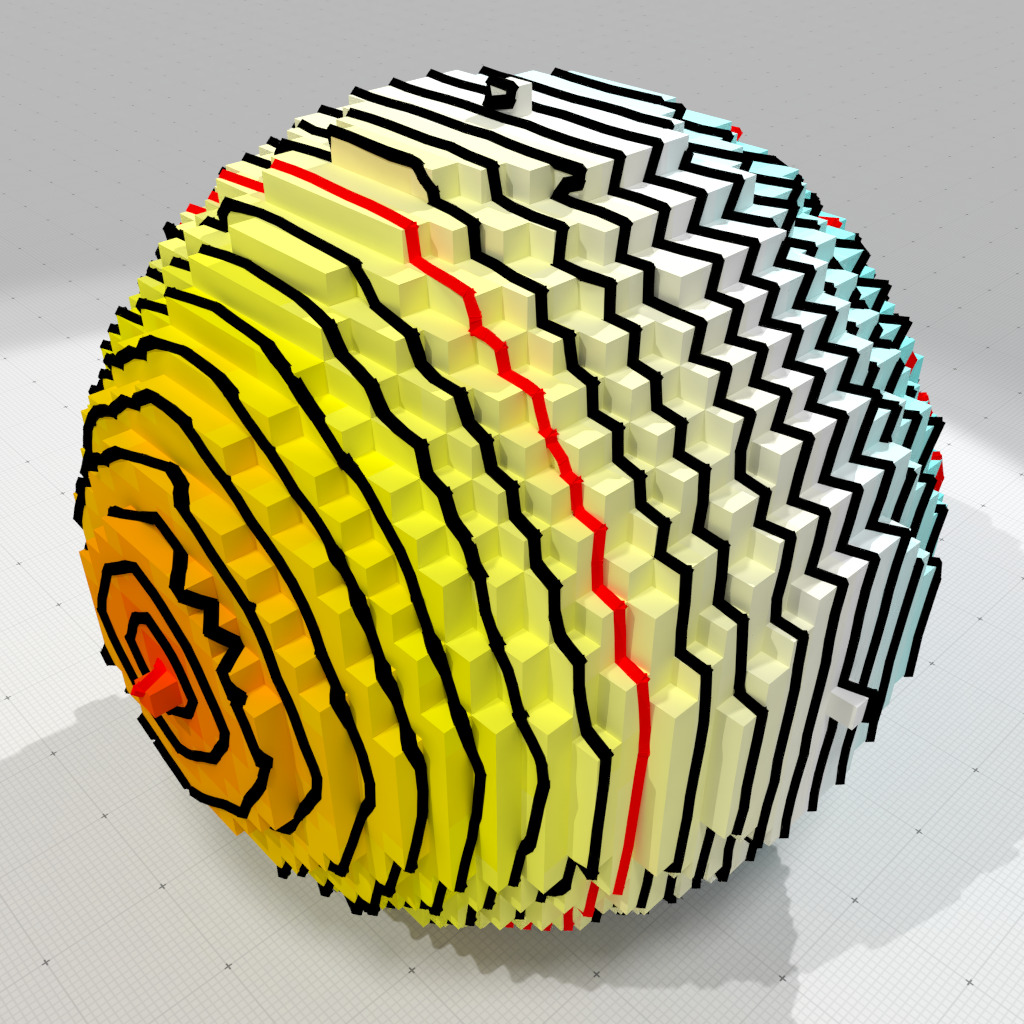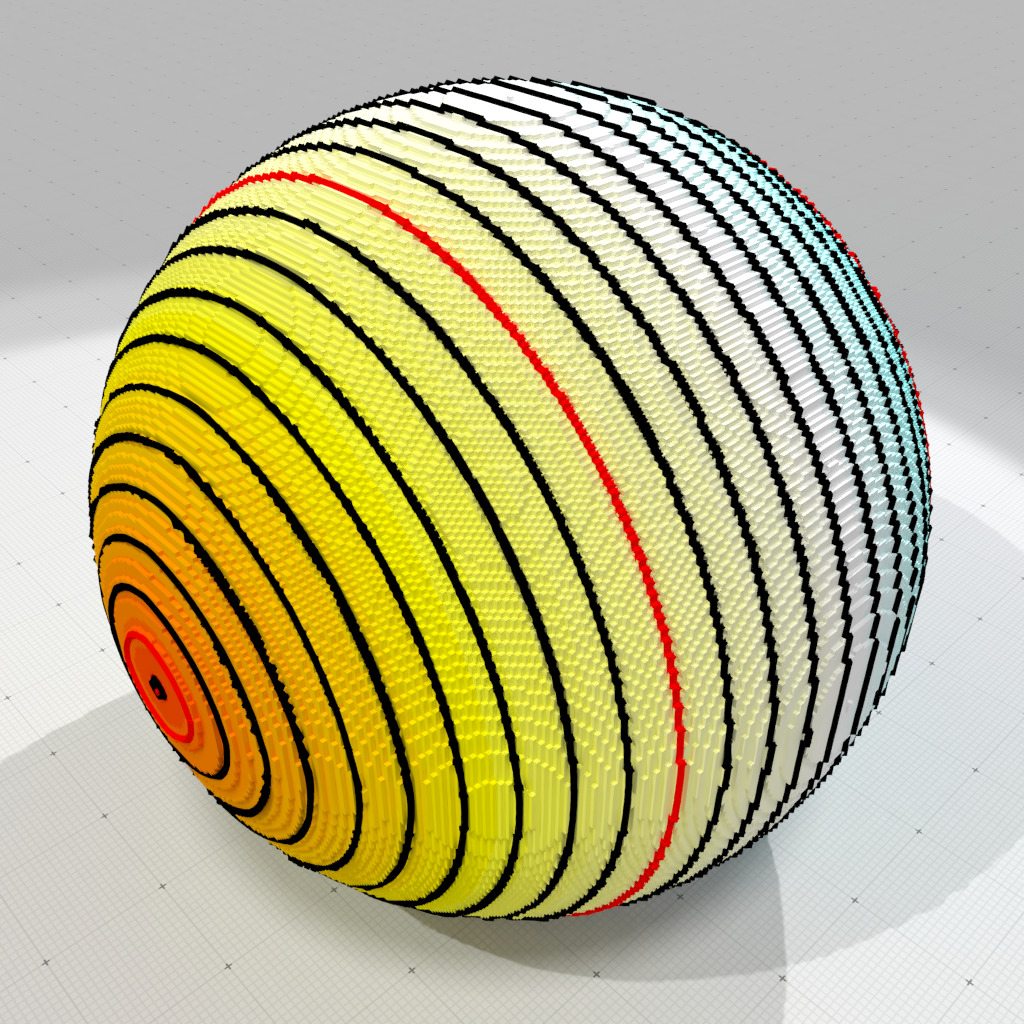Loading...
Searching...
No Matches
geometry/volumes/fullConvexitySphereGeodesics.cpp
This example shows how to use tangency to compute exact or approximate geodesic shortest paths on 3D digital objects, here a unit sphere digitized at your chosen gridstep.
For instance, you may call it with a digitization gridstep 0.0625 and parameter 1.8 (greater than sqrt(3), so guarantees exact shortest paths).
./examples/geometry/volumes/fullConvexitySphereGeodesics 0.0625 1.8
and outputs
Usage: ./examples/geometry/volumes/fullConvexitySphereGeodesics <h> <opt>
Computes shortest paths to a source point on a sphere digitized with gridstep <h>.
- h [==1.0]: digitization gridstep
- opt [==sqrt(3)]: >= sqrt(3): secure shortest paths, 0: fast
New Block [Building sphere1 shape ... ]
EndBlock [Building sphere1 shape ... ] (13.2603 ms)
New Block [Build mesh from primal surface]
#surfels =4782
#pointels=4784
[SurfaceMesh (OK) #V=4784 #VN=0 #E=9564 #F=4782 #FN=0 E[IF]=4 E[IV]=3.99833 E[IFE]=2]
EndBlock [Build mesh from primal surface] (111.024 ms)
New Block [Compute geodesics]
EndBlock [Compute geodesics] (11958.8 ms)
Max distance is 3.02389
Comput. time is 11958.8
Last index is 3698
Uppest index is 3698
New Block [Output Corrected HD OBJ files]
Max distance is 3.02389
EndBlock [Output Corrected HD OBJ files] (494.499 ms)
It computes all shortest paths to the lowest point of the digitized sphere, outputs the maximal distance (so less than pi), and checks that the furthest point is indeed antipodal to the source point. Two OBJ files named "sphere1-geodesics.obj "and "sphere1-geodesics-iso.obj" are also outputed, and you may use them to render the result like below.

Exact geodesic distances on unit sphere digitized at h=0.0625 (max d=3.02389) | 
Approximate geodesic distances on unit sphere digitized at h=0.01 (max d=3.1269) |
#include <iostream>
#include <queue>
#include "DGtal/base/Common.h"
#include "DGtal/shapes/Shapes.h"
#include "DGtal/shapes/SurfaceMesh.h"
#include "DGtal/helpers/StdDefs.h"
#include "DGtal/helpers/Shortcuts.h"
#include "DGtal/images/ImageContainerBySTLVector.h"
#include "DGtal/io/writers/SurfaceMeshWriter.h"
#include "DGtal/geometry/volumes/TangencyComputer.h"
using namespace std;
using namespace DGtal;
typedef Space::RealVector RealVector;
const std::vector< double >& vvalues,
int nb_isolines_per_unit = 10,
const double thickness = 0.1 )
{
std::string cobjname = output;
std::string cisoname = output + "-iso";
auto quantify = [] ( double v, double m, double nb )
{ return round( v/m*nb )*m/nb; };
double maxValue = * ( std::max_element( vvalues.cbegin(), vvalues.cend() ) );
double minValue = * ( std::min_element( vvalues.cbegin(), vvalues.cend() ) );
double maxDist = maxValue - minValue;
auto cmap = SH3::getColorMap( 0.0, maxDist );
std::vector< Color > fcolors( surfmesh.nbFaces() );
for ( Index f = 0; f < fvalues.size(); ++f )
fcolors[ f ] = cmap( quantify( fvalues[ f ] - minValue, maxDist, 50 ) );
SMeshWriter::writeOBJ( cobjname, surfmesh, fcolors );
double unit = pow( 10.0, floor( log( maxDist ) / log( 10.0 ) ) - 1.0 );
const int N = 10 * nb_isolines_per_unit;
std::vector< double > isolines( N );
std::vector< Color > isocolors( N );
for ( int i = 0; i < N; i++ )
{
isolines [ i ] = (double) i * 10.0 * unit / (double) nb_isolines_per_unit
+ minValue;
isocolors[ i ] = ( i % nb_isolines_per_unit == 0 )
? Color::Red : Color::Black;
}
SMeshWriter::writeIsoLinesOBJ( cisoname, surfmesh, fvalues, vvalues,
isolines, thickness, isocolors );
trace.endBlock();
}
{
trace.info() << "\tComputes shortest paths to a source point on a sphere digitized with gridstep <h>." << std::endl;
trace.info() << "\t- h [==1.0]: digitization gridstep" << std::endl;
trace.info() << "\t- opt [==sqrt(3)]: >= sqrt(3): secure shortest paths, 0: fast" << std::endl;
double h = argc > 1 ? atof( argv[ 1 ] ) : 0.0625; //< exact (sqrt(3)) or inexact (0) computations
double opt = argc > 2 ? atof( argv[ 2 ] ) : sqrt(3.0); //< exact (sqrt(3)) or inexact (0) computations
// Domain creation from two bounding points.
trace.beginBlock( "Building sphere1 shape ... " );
auto params = SH3::defaultParameters();
params( "polynomial", "sphere1" )( "gridstep", h );
params( "minAABB", -2)( "maxAABB", 2)( "offset", 1.0 )( "closed", 1 );
auto implicit_shape = SH3::makeImplicitShape3D ( params );
auto digitized_shape = SH3::makeDigitizedImplicitShape3D( implicit_shape, params );
params );
trace.endBlock();
trace.beginBlock( "Build mesh from primal surface" );
// Compute surface
// Build a mesh
SMesh smesh;
auto embedder = SH3::getCellEmbedder( K );
std::vector< Point > lattice_points;
SH3::RealPoints vertices;
std::vector< Vertices > faces;
SH3::Cell2Index c2i;
auto pointels = SH3::getPointelRange( c2i, surface );
trace.info() << "#pointels=" << pointels.size() << std::endl;
vertices = SH3::RealPoints( pointels.size() );
std::transform( pointels.cbegin(), pointels.cend(), vertices.begin(),
[&] (const SH3::Cell& c) { return h * embedder( c ); } );
// Build faces
{
std::vector< Index > face;
for ( auto&& primal_vtx : primal_surfel_vtcs )
face.push_back( c2i[ primal_vtx ] );
faces.push_back( face );
}
faces.cbegin(), faces.cend() );
// Find lowest and uppest point.
const Index nb = lattice_points.size();
Index lowest = 0;
Index uppest = 0;
for ( Index i = 1; i < nb; i++ )
{
if ( lattice_points[ i ] < lattice_points[ lowest ] ) lowest = i;
if ( lattice_points[ uppest ] < lattice_points[ i ] ) uppest = i;
}
// Extracts shortest paths to a target
typedef TangencyComputer< KSpace >::Index tcIndex;
TC.init( lattice_points.cbegin(), lattice_points.cend() );
auto SP = TC.makeShortestPaths( opt );
SP.init( lowest ); //< set source
double last_distance = 0.0;
tcIndex last = 0;
while ( ! SP.finished() )
{
last = std::get<0>( SP.current() );
last_distance = std::get<2>( SP.current() );
SP.expand();
}
std::cout << "Max distance is " << last_distance*h << std::endl;
std::cout << "Comput. time is " << time << std::endl;
std::cout << "Last index is " << last << std::endl;
std::cout << "Uppest index is " << uppest << std::endl;
// Export surface for display
std::vector<double> distances = SP.distances();
for ( tcIndex i = 0; i < distances.size(); i++ )
distances[ i ] *= h;
saveToObj( "sphere1-geodesics", smesh, distances, 10, 0.1 );
return 0;
}
// //
Aim: This class is a model of CCellularGridSpaceND. It represents the cubical grid as a cell complex,...
Definition KhalimskySpaceND.h:394
Aim: This class is used to simplify shape and surface creation. With it, you can create new shapes an...
Definition Shortcuts.h:102
Definition SpaceND.h:96
Aim: A class that computes tangency to a given digital set. It provides services to compute all the c...
Definition TangencyComputer.h:74
void beginBlock(const std::string &keyword="")
std::ostream & info()
double endBlock()
void saveToObj(const std::string &output, const SMesh &surfmesh, const std::vector< double > &vvalues, int nb_isolines_per_unit=10, const double thickness=0.1)
Definition fullConvexitySphereGeodesics.cpp:120
SurfaceMeshWriter< RealPoint, RealVector > SMeshWriter
Definition fullConvexitySphereGeodesics.cpp:116
DGtal is the top-level namespace which contains all DGtal functions and types.
Definition ClosedIntegerHalfPlane.h:49
Trace trace
std::pair< typename graph_traits< DGtal::DigitalSurface< TDigitalSurfaceContainer > >::vertex_iterator, typename graph_traits< DGtal::DigitalSurface< TDigitalSurfaceContainer > >::vertex_iterator > vertices(const DGtal::DigitalSurface< TDigitalSurfaceContainer > &digSurf)
STL namespace.
Represents a signed cell in a cellular grid space by its Khalimsky coordinates and a boolean value.
Definition KhalimskySpaceND.h:209
Aim: An helper class for writing mesh file formats (Waverfront OBJ at this point) and creating a Surf...
Definition SurfaceMeshWriter.h:65
Aim: Represents an embedded mesh as faces and a list of vertices. Vertices may be shared among faces ...
Definition SurfaceMesh.h:92